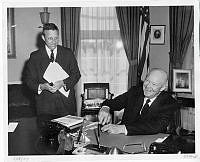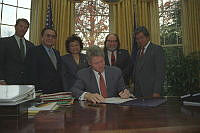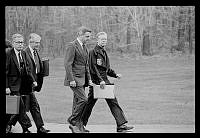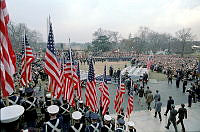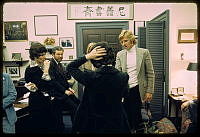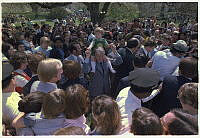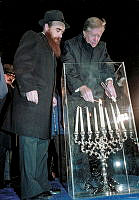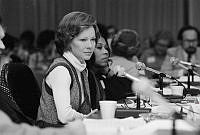Rubenstein Center Scholarship
Christmas with the Roosevelts
Gallery
-

President Franklin D. Roosevelt with his grandchildren Franklin D. Roosevelt III (left) and John R. Boettiger (right) on December 24, 1939.
Franklin D. Roosevelt Presidential Library and Museum/NARA -

President Roosevelt delivers his Christmas address from the South Portico during the National Christmas Tree lighting ceremony on December 24, 1941. British Prime Minister Winston Churchill (right) gave a speech after the president.
Franklin D. Roosevelt Presidential Library and Museum/NARA -

President Roosevelt surrounded by his grandchildren at Hyde Park on December 24, 1943. From left to right are Franklin D. Roosevelt III; Curtis “Buzzie”; Christopher duPont Roosevelt; the president; Ann Roosevelt; Eleanor “Sistie” Dall; John Boettiger; and Haven Roosevelt.
Franklin D. Roosevelt Presidential Library and Museum/NARA -

President Roosevelt prepares to give his radio address for the National Christmas Tree lighting from his study at Hyde Park on December 24, 1943.
Franklin D. Roosevelt Presidential Library and Museum/NARA
The White House has many holiday traditions, some of which are historic and others more recent. New arrivals to the Executive Mansion often bring unique familial rituals that they celebrate alongside time-tested White House and presidential customs. During the holiday season, the president and first lady participate in public traditions such as receiving a tree for the Blue Room, lighting the National Christmas Tree on the Ellipse, and offering their blessings in an address to the nation. The White House, however, is also a private home and has been used by many presidents to celebrate Christmas with family, friends, and invited guests.
During his twelve years in office, President Franklin Roosevelt spent ten consecutive Christmases at the White House and his last two at the family home in Hyde Park, New York. Despite the lingering effects and uncertainty of the Great Depression, the first ten holidays generally followed the same pattern. On Christmas Eve, the president and first lady hosted an annual party for White House staff. White House policemen, chauffeurs, butlers, maids, cooks, and office employees gathered with their families in the East Room for refreshments, merriment, and gifts. President Roosevelt and First Lady Eleanor Roosevelt made an effort to greet all the attendees, shake their hands, and give out small tokens of appreciation for their hard work. In 1934, they gave autographed copies of the president’s book On Our Way. Between 1935 and 1939, craftsmen at Eleanor’s Val-Kill manufactory produced pewter pieces such as letter openers, mail organizers, and paperweights as presents. In honor of the Roosevelts’ new pup Fala, staff members received key chains of the Scottish terrier in 1940.1 These parties often entertained 225-300 people, and were held every December.
After the White House employee festivities ended, the Roosevelts bundled up and headed out to light the National Christmas Tree.2 While today’s tree is displayed on the Ellipse, the tree lighting moved around during Roosevelt’s time in office. In 1933 it took place near Sherman Square, just east of the Executive Mansion. A year later, two Fraser fir trees were planted in Lafayette Park for future lighting ceremonies.3 In 1939, the National Christmas Tree was placed on the Ellipse. Regardless of location, the Roosevelts participated in the lighting ritual every year.
After the tree was illuminated in 1933, the president offered his blessings to the nation in his first Christmas radio address. He wove one of his favorite adages, “Love thy neighbor as thyself,” into his holiday speech, noting that this teaching had “taken on a meaning that is showing itself and proving itself in our purposes and daily lives.”4 He also thanked citizens for their sincerity and generosity that December. According to a Washington Post report, the White House had handled some 40,000 pieces of Christmas mail the day before.5 Roosevelt also received a telegram with nearly 7,000 signatures from residents of the Tennessee Valley, who thanked him for the Tennessee Valley Authority’s assistance and wished him well for the Christmas season.6 After the president’s broadcast concluded, the Roosevelts returned to the White House to hear a performance by the Washington Choral Society. As the celebration wound down, the Roosevelt children and grandchildren ascended to the Residence to partake in two of the president’s favorite holiday traditions: hanging stockings in his bedroom and reading Charles Dickens’ classic, A Christmas Carol.7

President Franklin Roosevelt and First Lady Eleanor Roosevelt attend the National Christmas Tree lighting on December 24, 1933. Girl Scout Margaret Lusby gives a bouquet of red roses to the first lady and her granddaughter, Anna Eleanor “Sistie” Dall.
Franklin D. Roosevelt Presidential Library and Museum/NARAOn Christmas morning, the grandchildren typically went to wake their grandfather, who then sent them to rouse the other guests. As the Roosevelt family grew during the 1930s, the grandchildren became more rambunctious in the early morning hours, so much so that Eleanor instructed them to wake her first so the president could sleep a little longer.8 Once the president was up, the family crowded into his bedchamber to take down their stockings. In 1940, even Fala had his own stocking containing a rubber bone and an assortment of dog toys. However, according to one newspaper account the dog was far more interested in “a 6-inch mechanical Scotty that came out of the President’s sock.”9
After breakfast, the family departed the White House for Christmas Day services. During their time in Washington, the Roosevelts often attended St. Thomas’ Church or the Church of the Covenant, but they also visited Foundry Methodist Church, First Congregational Church, and Calvary First Presbyterian Church.10 In the afternoon, the Roosevelt family assembled to exchange presents and open some of the many gifts sent to the president from across the country and around the world. In 1934, some 6,000 presents arrived at the White House before Christmas. According to one report, there were “nine turkeys so far; ducks, pheasants and quail beyond number; crates of oranges and grapefruit; and the cakes are coming in by the dozen.” The highlights were a “big buck deer” given by the Woodmont Rod and Gun Club and a 150-pound fruitcake.11 The following year, the club gave the president a wild turkey that was later served in the State Dining Room.12 The annual Christmas dinner featured a number of family favorites such as roasted turkey, chestnut dressing, sweet potatoes, cranberry sauce, pineapple salad, and calf’s head soup. For dessert, the Roosevelts often feasted on plum pudding, eggnog, ice cream, and a variety of delicious cakes.13
Most of the perishable gifts and presents sent to the Roosevelts were donated to local charities. Within this spirit of giving, First Lady Eleanor Roosevelt participated in a number of worthy causes during the Christmas season. Beginning in 1936, she visited African-American and working-class neighborhoods to attend their respective tree lightings, where she would often speak and disperse gifts to the city’s poorer residents.14 She also worked with organizations such as the Salvation Army, the Central Union Mission, and the Kiwanis Club of Arlington. On Christmas Eve 1940, she stopped off at the Central Union Mission’s Christmas party to help distribute presents and food bags to over 1,500 children. After the tree lighting ceremony on the Ellipse, Eleanor traveled to Green’s Court, “an inhabited alley” to deliver Christmas cheer. Her seasonal hospitality extended to the White House as well. As the honorary president of the Girl Scouts of America, Eleanor invited 50 lucky scouts in 1936 to sing Christmas carols in the East Room.15

This photograph shows visitors admiring a decorated Christmas tree in December 1934. The tree stands in the East Room, which was the preferred space because of the room’s height.
White House Historical AssociationThese Christmas traditions were transformed in December 1941. After the surprise attack at Pearl Harbor, national defense and public safety became major priorities for the federal government. Some even advocated cancelling the National Christmas Tree lighting that year, fearing that America’s enemies might attack the 40,000 expected attendees. “War and blackouts notwithstanding, plans are going forward for the public to be admitted to the White House south grounds Christmas Eve for the lighting by President Roosevelt of the National Community Christmas Tree,” wrote one correspondent.16 Additional security precautions were taken as President Roosevelt, joined by British Prime Minister Winston Churchill, illuminated the Christmas tree from the South Portico. In his address, Roosevelt acknowledged that some considered it inappropriate to light trees and give gifts this season under the circumstances. However, he reasoned that the “dignity and brotherhood of man which Christmas Day signifies-more than any other day or any other symbol” would serve as the country’s greatest weapon against “enemies who preach the principles of hate and practice them.”17 While Roosevelt would continue to participate in the National Christmas Tree lighting from the confines of the White House and later from his Hyde Park residence, the brightly colored bulbs for the tree were replaced by highly decorated ornaments produced by local schoolchildren in an effort to promote wartime conservation.18
The Roosevelts tried to maintain their customary Christmas activities and traditions but World War II made that exceedingly difficult. The four Roosevelt sons—James, Elliott, Franklin Jr., and John—were all on active duty in different branches of the Armed Forces. Daughter Anna Roosevelt Boettiger lived across the country in Seattle, Washington. 1941 was the first time that the Roosevelts celebrated Christmas without their children and grandchildren.19 Over the next few years, the war scattered the Roosevelt boys across the globe, making it impossible for the entire family to celebrate the holiday together.

The Roosevelt family leaving for St. Thomas’ Church on December 25, 1938. Left to right are Mrs. Elizabeth Riley Roosevelt, sister-in-law of the president; First Lady Eleanor Roosevelt; Sara Roosevelt, mother of the president; Franklin D. Roosevelt, James Roosevelt and his wife, Mrs. Betsy Roosevelt; Franklin D. Roosevelt Jr., and Harry Hopkins, the Secretary of Commerce. The two children in front are Sara Delano Roosevelt, daughter of James Roosevelt, and Diana Hopkins.
Library of CongressDuring his last two Christmases away from the White House, President Roosevelt cherished those who could make it while maintaining focus on the war effort. On Christmas Eve 1943, he delivered one of his famous Fireside Chats from Hyde Park. “We may look forward into the future with real, substantial confidence that, however great the cost, ‘peace on earth, good will toward men’ can be and will be realized and insured,” he remarked.20 As the family gathered afterwards to exchange presents in the family library, they were surprised to see unwrapped gifts scattered beneath the tree. The president had requested this in order “to save paper.”21 The Roosevelts continued to host their annual party for the White House staff and Executive Office employees, but their gifts also reflected the impact of the war. In 1942, each employee received a black leather folder filled with war savings bonds. In 1944, the president gave each staff member a scroll with his “D-Day Prayer.”22 The paper was engraved with black, gold, red and blue letters, and signed “Christmas, 1944—from FDR.”23
In 1944, some 15,000 Americans gathered near the South Lawn to see the National Christmas Tree and listen to what would be President Roosevelt’s last Christmas message. First Lady Eleanor Roosevelt invited wounded servicemen from Walter Reed General Hospital and their families to enjoy the ceremonies from the comfort of the South Portico. The tree was “speckled with hundreds of brilliant ornaments contributed by the children of Washington,” wrote one reporter. The United States Marine Band provided lively seasonal music while the jubilant crowds sang along.24 Nearly 300 miles away in his study at Hyde Park, President Roosevelt delivered his address to the nation and the world: “We pray that with victory will come a new day of peace on earth in which all the Nations of the earth will join together for all time. That is the spirit of Christmas, the holy day. May that spirit live and grow throughout the world in all the years to come.”25














